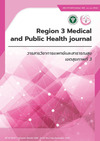การศึกษาทบทวนของโปรแกรมการคัดกรองการได้ยินในทารกแรกเกิดทุกรายในจังหวัดนครสวรรค์: คาดหวังผลลัพธ์ที่ดีขึ้น
คำสำคัญ:
โปรแกรมการคัดกรองการได้ยินในทารกแรกเกิดทุกราย, การสูญเสียการได้ยิน, การทดสอบการวัดเสียงสะท้อนจากหูชั้นในบทคัดย่อ
ที่มา: ปัญหาการสูญเสียการได้ยินของทารกแรกเกิดเป็นปัญหาที่สำคัญทางด้านสุขภาพที่มีผลกระทบต่อการพัฒนาการ การสื่อสาร ภาษา การเรียนรู้และสติปัญญาของทารก โปรแกรมการคัดกรองการได้ยินในทารกแรกเกิดทุกราย (Universal Neonatal Hearing Screening: UNHS) มีเป้าหมายเพื่อตรวจพบปัญหาการได้ยินในทารกแรกเกิดในระยะแรก เพื่อให้มีการแก้ไขที่ทันเวลาและมีผลลัพธ์ที่ดีขึ้น
วัตถุประสงค์: การศึกษาทบทวนนี้มีวัตถุประสงค์เพื่อประเมินประสิทธิภาพของโปรแกรม UNHS ในจังหวัดนครสวรรค์ โดยเฉพาะเรื่องอัตราครอบคลุมการคัดกรอง การตรวจพบทารกแรกเกิดที่มีความเสี่ยงสูง อัตราการเกิดความผิดปกติทางการได้ยิน (Referral rate) อัตราส่วนของการสูญเสียการได้ยิน และปัจจัยเสี่ยงทางการได้ยิน
วิธีการศึกษา: สะสมข้อมูลตั้งแต่พฤศจิกายน พ.ศ. 2564 ถึงพฤษภาคม พ.ศ. 2566 จากโรงพยาบาลทั้งหมด 20 แห่ง ที่ร่วมรายการ UNHS โดยทำการคัดกรองด้วยการทดสอบการวัดเสียงสะท้อนจากหูชั้นใน (Transient evoked otoacoustic emissions: TEOAEs) หรือเครื่องตรวจการได้ยินระดับก้านสมองอัตโนมัติ (Automatic auditory brain stem response: AABR) สำหรับทารกแรกเกิดที่มีผลตรวจคัดกรองผิดปกติ จะส่งตรวจวินิจฉัยเพิ่มเติมด้วยเครื่องตรวจการได้ยินระดับก้านสมอง Auditory Brainstem Response/ Auditory steady-state response (ABR/ASSR) ต่อไป
ผลการศึกษา: ทารกแรกเกิดทั้งหมด 2,623 ราย ที่ผ่านการคัดกรอง ซึ่งเป็นสัดส่วนของการครอบคลุมอยู่ที่ 66.8% ในทารกที่ผ่านการคัดกรอง 15.0% ได้รับการจัดว่าเป็นเสี่ยงสูง แนวทางการคัดกรองแบบสองขั้นตอนแสดงการลดลงอย่างมีนัยสำคัญในอัตราส่วนการส่งต่อลดลงจาก 18.6% เป็น 6.63% ปัจจัยเสี่ยงที่พบบ่อยที่สุดในจังหวัดนครสวรรค์คือ ยา Ototoxic ซึ่งมีสัดส่วน 80.3% การคลอดก่อนกำหนด (Preterm labor) ซึ่งมีสัดส่วน 32.50% และการอยู่ในห้อง NICU นานกว่า 5 วัน ซึ่งมีสัดส่วน 21.70%
สรุป: โปรแกรม UNHS ในจังหวัดนครสวรรค์มีบทบาทสำคัญในการเพิ่มผลลัพธ์ที่ดีขึ้นสำหรับทารกที่มีการสูญเสียการได้ยิน และให้ข้อมูลที่มีคุณค่าให้แก่ผู้บริหารและบุคลากรสาธารณสุขที่เกี่ยวข้อง การรักษาความสำเร็จและการสนับสนุนต่อไปของโปรแกรม UNHS เป็นสิ่งสำคัญเพื่อให้มั่นใจในคุณภาพชีวิตของทารกแรกเกิดที่ดีขึ้น
คำสำคัญ: โปรแกรมการคัดกรองการได้ยินในทารกแรกเกิดทุกราย, การสูญเสียการได้ยิน, การทดสอบการวัดเสียงสะท้อนจากหูชั้นใน
เอกสารอ้างอิง
Connolly JL, Carron JD, Roark SD. Universal newborn hearing screening: are we achieving the Joint Committee on Infant Hearing (JCIH) objectives? Laryngoscope 2005;115(2):232–6.
Fortnum HM, Summerfield AQ, Marshall DH, Davis AC, Bamford JM. Prevalence of permanent childhood hearing impairment in the United Kingdom and implications for universal neonatal hearing screening: questionnaire based ascertainment study. BMJ 2001; 323;536–40.
Erenberg A, Lemons J, Sia C, Trunkel D, Ziring P. Newborn and infant hearing loss: detection and intervention. American Academy of Pediatrics. Task Force on Newborn and Infant Hearing 1999;103:527–30.
Robertson CM , Howarth TM, Bork DL, Dinu IA. Permanent bilateral sensory and neural hearing loss of children after neonatal intensive care because of extreme prematurity: a thirty-year study. Pediatrics 2009;123(5):797–807.
Jakubı´kova´ J, Z. Kaba’tova, Pavlovcinova’G, Profant M. Newborn hearing screening and strategy for early detection of hearing loss in infants. Int. J. Pediatr Otorhinolaryngol 2009;73(4): 607–12.
Isaacson G. Universal Newborn Hearing Screening and Intervention. Advances in Otolaryngology-Head and Neck Surgery 2001;15:1-19.
Molini E, Calzolaro L, Lapenna R, Ricci G. Universal newborn hearing screening in Umbria region, Italy. International journal of pediatric Otorhinolaryngology 2016;82:92-7.
Sloot F, Hoeve HL, de Kroon ML, Goedegebure A, Carlton J, Griffiths HJ, et al. Inventory of current EU paediatric vision and hearing screening programmes. J Med Screen 2015;22:55–64.
Mehl AL, Thomson V. The Colorado newborn hearing screening project 1992-1999: on the threshold of effective population-based universal newborn hearing screening. Pediatrics 2002;109: E7.
Bubbico L, Tognola G, Greco A, Grandori F. Universal newborn hearing screening programs in Italy: survey of year 2006, Acta Otolaryngol 2008; 128(12):1329–36.
ASHA: American Speech-Language-Hearing Association.Joint Committee on infant Hearing. Position Statement. ASHA 1994;36:38-41.
Wroblewska-Seniuk KE, Dabrowski P, Szyfter W, Mazela J. Universal newborn hearing screening: methods and results, obstacles, and benefits. Pediatr Res 2017;81:415–22.
Force USPST. Universal screening for hearing loss in newborns: US preventive services task force recommendation statement. Pediatrics 2008; 122:143–8.
Downs MP, Yoshinaga-Itano C. The efficacy of early identification and intervention for children with hearing impairment. Pediatr Clin N Am 1999; 46:79–87.
Caluraud S, Marcolla-Bouchetemble A, de Barros A, Moreau-Lenoir F, de Sevin E, Rerolle S,et al. Newborn hearing screening: analysis and outcomes after 100,000 births in upper-Normandy French region. Int J Pediatr Otorhinolaryngol 2015;79:829–33.
American Academy of Pediatrics JCoIH. Year 2007 position statement: principles and guidelines for early hearing detection and intervention programs. Pediatrics 2007;120:898–921.
Joint Committee on Infant H, American Academy of A, American Academy of P, American Speech -Language-Hearing A, Directors of S, Hearing Programs in State H, Welfare A. Year 2000 position statement: principles and guidelines for early hearing detection and intervention programs. Joint Committee on Infant Hearing, American Academy of Audiology, American Academy of Pediatrics, American Speech-Language-Hearing Association and Directors of Speech and Hearing Programs in State Health and Welfare Agencies. Pediatrics 2000;106:798–817.
Yang HC, Sung CM, Shin DJ, Cho YB, Jang CH, Cho HH. Newborn hearing screening in prematurity: fate of screening failures and auditory maturation. Clin Otolaryngol. 2017;42(3): 661-7.
Dommelen P, Straaten HM, Verkerk PH. NICU Neonatal Hearing Screening Working Group. Ten-year quality assurance of the nationwide hearing screening programme in Dutch neonatal intensive care units. Acta Paediatr Oslo Nor 2011;100(8): 1097-103.
Iley KL, Addis RJ. Impact of technology choice on service provision for universal newborn hearing screening within a busy district hospital. JPerinatol 2000;20(8): 122‑7.
ดาวน์โหลด
เผยแพร่แล้ว
วิธีการอ้างอิง
ฉบับ
บท
การอนุญาต
ลิขสิทธิ์ (c) 2024 Region 3 Medical and Public Health Journal - วารสารวิชาการแพทย์และสาธารณสุข เขตสุขภาพที่ 3

This work is licensed under a Creative Commons Attribution-NonCommercial-NoDerivatives 4.0 International License.




